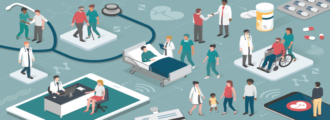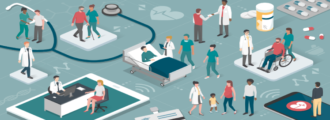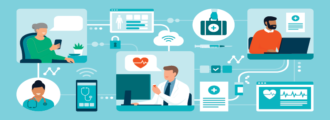Those who’ve spent any amount of time in the world of healthcare IT have probably asked themselves, “What is HL7?” at one time or another. Even if you know that HL7 means “Health Level Seven,” why are there levels? (And what does each level mean?)
Read on to learn a bit more about what HL7 is, how healthcare IT professionals use it, and how an expert healthcare integration consultant can help you make the most of it.
What is HL7?
First, let’s explain the name.
The “level” and “seven” in HL7 refers to the OSI model, or Open Systems Interconnection model, a way of thinking about telecommunication and computer systems. Starting at the first layer, Physical, we work our way down to the seventh and final layer, the Application level, where HL7 lives. The purpose of the OSI model in general (and HL7 in particular) is to provide a common set of standards for everyone to use to ensure healthcare information systems can interact with each other sensibly.
In other words, while HL7 does refer to the “Application” layer, it’s not a program or a technology itself, but rather a big “book of rules” that says how healthcare technologies should communicate with each other. It’s essentially like an international referee that says that everybody in the healthcare enterprise can write in different languages, but they need to use the same rules to translate. and share data
What Does HL7 Provide for Healthcare Organizations?
HL7 standards were created by Health Level Seven International, and they are used to provide guidance for data transferring and sharing processes between healthcare providers and organizations. In a continuously growing healthcare industry, consistent data standards and comprehensive system frameworks are crucial to the management of electronic health information.
HL7 provides the guidelines needed to help healthcare providers understand (and optimize) two of the most critical focal points throughout the healthcare industry: electronic health record (EHR) systems and interoperability. For healthcare organizations, EHRs play an important role in ensuring data is managed, stored, and transferred properly. And, in order to maximize the value of those EHRs for any organization, interoperability between important information systems is key.
Fortunately, HL7 outlines standards that assist healthcare providers with thee exchange of data, sharing, integration, and retrieval, making it easier for organizations to exchange information across their EHRs with less room for miscommunication or misinterpretation. Now, you may be wondering…”If HL7 is composed of a number of different standards for healthcare interoperability, what are those standards?”
Let’s dive into a few of the key primary standards found in HL7.
What Are the Primary HL7 Standards?
There’s a lot to HL7 standards, but there are a handful of standards that the HL7 organization considers “primary,” (i.e., the most popular and frequently used standards in system integrations and interoperability).
Here are the primary HL7 standards that are most important for HL7 integrations:
C-CDA Implementation Guide
A library of CDA templates, this guide is an updated harmonization of several previous HL7 components, including HL7, Integrating the Healthcare Experience (IHE), and Health Information Technology Standards Panel (HITSP).
CDA® Release 2
This standard defines what a “clinical document” is, how they must be structured, and what their semantics look like so that they can be intelligently shared between healthcare organizations.
FHIR® R4 (HL7 Fast Healthcare Interoperability Resources, Release 4)
An interoperability standard, Fast Healthcare Interoperability Resources (FHIR), is designed to make the exchange of healthcare info between patients, carers, researchers, healthcare organizations, (and anyone else involved in the healthcare ecosystem) as seamless as possible through the use of a content model as well as specifications for how that content can be exchanged.
HL7 Context Management Specification (CCOW), Version 1.6
The purpose of the CCOW standard is to ensure that applications are integrated at the point of use. CCOW provides a framework for how internal applications programming and runtime environment infrastructure should be created so that they are synchronized and that patient information can be consistently accessed, even from a wide variety of sources.
Version 2 Product Suite
What is likely the most widely implemented healthcare standard in the world, HL7 V2 is a messaging standard that says how clinical data should be exchanged between systems, from central patient care systems to more segmented healthcare systems where data is divided up by department.
Version 3 Product Suite
HL7 V3 Normative Edition (based off the HL7 Reference Information Model) is an interoperability standard that focuses on HL7 messages and electronic documents expressed in XML syntax.
Key Benefits of HL7 Integrations
- Improved data uniformity: Legacy healthcare IT systems use outdated, siloed systems that use all kinds of different transmission protocols and data formats. HL7 simplifies this by providing cohesive, uniform data standards that help organizations achieve compatibility throughout their entire data exchange network.
- Standardized exchange of data: In the healthcare industry, there often lies a need for information sharing between an organization and other, external software vendors, systems, or facilities. HL7 goes beyond usual clinical and administrative data integration and transforms data exchange interoperability functions by using standardized HL7 FHIR integrations and web-based APIs to offer an easier connection between the two sides of the data exchange.
- Better decision-making: Reliable, accessible data is crucial in any organization, but even more so when lives are on the line (like in the healthcare industry). HL7 offers integrations and message standards that minimize the risk of inconsistent data, reduce system delays, and increase the speed (and accuracy) of decision-making processes.
- Enhanced patient care experience: HL7’s data framework, standards, and key integrations give patients and providers better access to personal, pharmaceutical, and diagnostic data. By providing better access to data and more simple connections between systems, patients can stay up-to-date with their own data and providers can use such data to create more personalized and efficient health services.
How to Make the Most of HL7
Now that we know what HL7 is, how do healthcare professionals actually use it?
Beyond the obvious (“They take advantage of EHR platforms that conform to HL7 standards”), most doctors, nurses, and other healthcare providers in the industry interact with HL7 through the kind of HL7 messages they send to transmit information from one system to another. For example, ADT is a HL7 message type that means “Admit, Discharge, Transfer,” MFN refers to “Master files notification,” an ACK is a general acknowledgment, and DFT refers to “Detailed financial management.”
By sending messages in this HL7 format, people that work at one hospital or clinic can communicate effectively with anyone who also uses the HL7 standards, improving efficiency and understanding and making sure that their patients receive excellent care based on accurate clinical and administrative data, no matter where they roam.
The HL7 Experts You Need
Even if they use the exact same solution, every healthcare provider uses its electronic health records (EHR) platform a little bit differently, which is why HL7 is such a vital part of medical service. Complying with the primary HL7 standards is oftentimes easier said than done.
That’s where Surety Systems comes in.
Surety Systems has an expansive team of senior-level healthcare interoperability consultants with experience in many different EHR systems and platforms. No matter how niche or unique your specific situation might be, we have just the right consultant to help you manage issues within your healthcare information systems (HIS).
Let us focus on handling technical problems so you can get back to doing what you do best—providing outstanding patient care.
How Can We Help?
Whether your healthcare organization needs help integrating HL7 standards, optimizing healthcare workflows, achieving interoperability, maintaining the entire health record, or anything in between, our consultants have the skills and experience to help.
And, even better, we’ve included a snapshot profile of one of our top-notch HL7 software consultants to give you a better idea of what to expect when partnering with our team:
Surety Senior HL7 Consultant
- Cloverleaf/Epic Bridges Certified HL7 Interface Programmer
- 25 years HL7 integration development experience
- Senior Level Cloverleaf developer, also experience developing with Corepoint and Rhapsody
- Epic Bridges Certified
- Experience integrating with Epic, McKesson, MEDITECH, Cerner/Siemens, and Allscripts systems
Interested in learning more about how our consultants can fill your needs (and gaining some insight from previous use cases)? Click here to check out an article about how one of our consultants gave their hospital client a competitive edge with Rhapsody Migration. And, if you’re still interested in more, take a look at another use case study, “Taking Healthcare Integrations from Overwhelming to Under Control”.
If you like what you’ve seen here, contact us today to get started.




